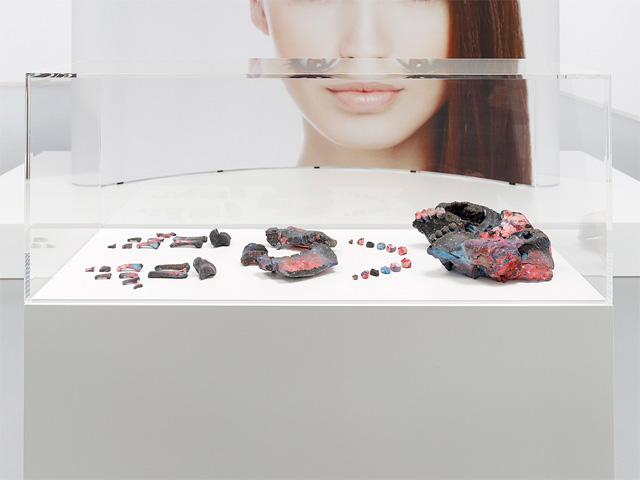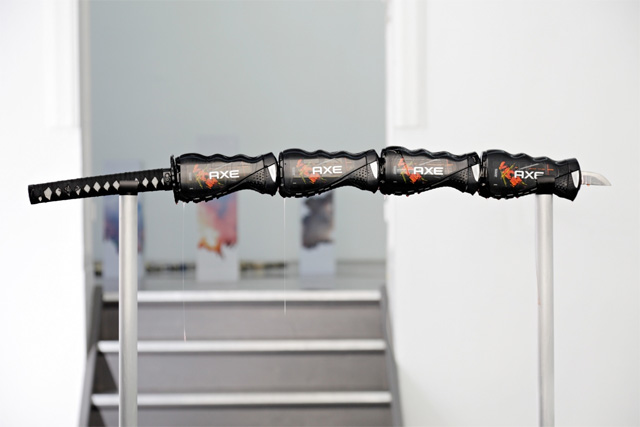In an article for DIS Magazine, ‘Stock Photography as Evolutionary Attractor‘, artist Timur Si-Qin writes about the predominance of particular conventions in commercial imagery; “the perspiring beverage bottle crashing through ice” or “the porcelain-skinned woman splashing water on her face”. Rather than giving the usual critical theory-laden account of why certain image conventions proliferate, Si-Qin looks to a range of possible factors, including human physiology and evolution. “For example, humans can see clearer and in color in the center of our vision”, he writes, “contributing to the compositional convention of central placement.” The article is telling of Si-Qin’s visual interest in everyday materials, one that seeks to situate them in an expanded context of human history and the natural world.
One of a growing number of post-internet artists associated with the contemporary philosophical movements of “New Materialism” and “Speculative Realism”, Si-Qin’s works frequently seek to detract from the aura of human self-importance. Exploring materials that range from Axe body wash, to Yoga mats, to stock photography, Si-Qin’s objects manage to both gently mock our preoccupations with health, appearance, virility, luxury, while linking such predilections to a pre-cultural era. When I ask (over email) why he thinks New Materialism resonates so strongly with visual artists, he responds, “I think, growing up, I was always enchanted by the natural world. New materialism is a philosophy that for the first time seems up to the task of acknowledging the myriad forms and shapes, animals and subjectivities, that seem to populate our contemporary experience.”

In Basin of Attraction, his first institutional solo show in Germany at the Bonner Kunstverein, Si-Qin created large-format digital images drawn from stock photography, as well as arrangements of bones (replicas of a hominid fossil) with patterned surfaces. It has long been the case in found-object art that materials be largely understood in the context of their recent social history. For Si-Qin, this is only one of multiple concerns regarding the way we make sense of materials, a view that incorporates form and structure as well knowledge from a range of disciplines. A stock image of “storied farmer’s hands sifting through bags of freshly roasted, aromatic coffee beans”, blown-up and mounted on a lightweight free-standing frame, comes straight from any advertising display in a suburban shopping centre. But Si-Qin does not draw attention to an object’s ubiquity to create kitsch, but rather to interrogate the broader question of why patterns reoccur so persistently. Chatting with Si-Qin over Skype, he is every bit as precise and theoretically focused as I have come to expect from his exhibition texts, easily traversing the various concepts and systems of knowledge that loosely fall under the rubric of new materialism.
Basin of Attraction explored your interest in stock and commercial photography, particularly in the recurring patterns we see in these images and their evolutionary genesis.
TS: Right, I’m interested in the deep chains of causality underlying the patterns we see in contemporary image culture. As well as the actual ways by which images are consumed and processed. The hyper-commercial aesthetic is a reflection of the contingent nature by which these recurring patterns arise. Patterns created by the interaction of instinctual and associated affects, as well as economic and political contingencies that manifest this whole global, cross-cultural aesthetic.
As someone from a generation where cultural studies and visual culture studies have been so dominant, it’s interesting to think about these other factors, evolutionary and biological for example. Do you think these get overlooked most of the time?
TS: I think they do often get overlooked. Because there’s little way of making sense of evolutionary or pre-cultural factors in a post-modern framework. But I think their introduction marks a turn away from the post-modern emphasis on language and cultural construction and towards a renewed emphasis on the objective and the material (without sacrificing subject and identity), like that found in philosophy in recent years under the banners of ‘new materialism’ or ‘speculative realism.’ I think the important thing to keep in mind, is that culture is an extension of biology, that it is a powerful adaptation in and of itself, but represents only a part of the spectrum of the full human/animal experience.
Which of your works were included in the Bonn exhibition? I understand you made 3D prints from fossils.
TS: Yeah, there are these three constellations, each consisting of a strain of commercial pop-up display and a vitrine with the 3D printed remains of a hominid teenager that lived in South Africa 1.5 – 2 million years ago. Each vitrine has different versions of the same individual, the same person that once lived. I was able to retrieve the digitalisation of his remains and make copies. I think what interests me about it is this causal history of shape and pattern, that the shapes of this person are echoing through time in varying guises; first before he was alive, through his ancestors, then after his death, the shapes were stored in fossilised rock, and now they’ve been scanned, digitized and 3d printed, but it’s still the same echo, the same shapes. In some ways I think the same thing goes for stock photos.
This idea reminds me of your work with ergonomic products. They are both about a trace of the human body.
TS: True, but I think the human part is arbitrary. I’m fascinated by animal bodies and nature in general, humans being is what we contingently connect with the most because we happen to be humans. Morphogenesis and vestigiality are the topics I’m really interested in.
Are you especially interested in these things as they relate to commodity culture? Commodity culture is a realm where we might least expect to find traces of our ancestry, it seems to come so directly from the here and now.
TS: I guess what I try to reflect is that there are these deeper older forces at play in the construction of the contemporary experience. That even though things are getting more sci-fi by the year, we owe the makeup of our reality in large part to the self organizing behaviour of matter (including human organization), which is the oldest story of all. However, I think that by acknowledging this causal history, it in no way results in any sort of determinism. In fact, I think it provides access to an ever greater flexibility of the future.
Yes, I think actually talking about these things might help to shift some of the older myths about evolution and biology that persist today, that are more essentialist.
TS: Yes, totally, it’s a pity how much these myths about evolution persist, especially in the humanities. Some equate an evolutionary lens with social-darwinism or genetic determinism. Both of which are based on false understandings of the radically flexible and non-teleological nature of evolution. Nature by way of evolution is inherently queer, generated only through variation and difference.

Was this a consideration in your works using Axe products? The Axe brand plays so much on these outdated ideas of scent and pheromones being able to trigger a response in the opposite sex. At the same time, the products also exploit very real evolution-based desires.
TS: I think what interested me was not so much the truth of the claims of the product, which is obviously over the top teenage boy catnip, but that a campaign and product like that can be as effective today as it is, which is again evidence of the power of the vestigial.
It must be! Axe is such an object of ridicule but remains so popular.
TS: Right, it’s a fossil. The bottles themselves look like fossils too. I think those pieces were successful in being a joke and being serious and enchanted by its subject at the same time, which is something I strive for. Like the stock cosmetics style portraits of females, which to me represents the opposite side of the spectrum of over-expressed male/female duality.
In both instances, I was fascinated by your ability to make these objects even more extreme in a way, piercing the Axe bottles with swords, blowing up the stock images.
TS: Yeah, I suppose it’s a way of creating some distance, but I’m also interested in riding this thin line between being critical of something and being complicit with it. I think because ultimately the distinction is maybe not there, or rather, that things are always more complicated than any simple duality.

You’re currently in a group show in Kassel at the Fridericianum; Speculations on Anonymous Materials. I thought the press text for this was interesting, it seemed to link the artists involved by the way they approach materials, instead of say, under the banner of post-internet art.
TS: Yeah I’m happy that for the first time there is a major exhibition of this generation that is moving beyond the post-Internet label. I think maybe the topics of medium-specificity and network technologies, subject matters that post-Internet seems to embody, are not sufficient in capturing a deeper generational shift. I think, ironically enough, what that label obfuscates is the true extent to which the internet and computers in general have changed our perception of the world.
The digital age has taught us that digital materials behave and are as real as physical materials, and vice versa, and that matter and reality is programmable, i.e. ‘the hackability of everything’. So what it comes down to, what’s really happening to our generation is maybe an expansion of the idea of materiality, one that counts everything, from Spanish to aluminum to Samsung as a material, each with its own manipulable properties and capacities.
There also seems to be a different, less formal attitude towards materials, in letting materials speak for themselves, rather than reflect the process of the artist.
TS: Yeah, I think you’re right; letting materials do what they want as a reflection of their contingent nature. One interesting thing is the repeated manifestations of certain things in this show and amongst the work of our generation, for example heads and hands. In a realist-materialist framework one can explain why images of faces and hands are especially able to connect to the viewer: we have special neural structures designed to process faces, and mirror neurons to feel the posture of hands which are a part of the body very densely populated with nerves. So in art as well as advertisement, we have come to understand that these images have an affectual weight. Their repeated use can therefore be thought of as an expression of the material properties and tendencies of our social/image world. I think our generation is intuiting this shift. **
Header Image: Timur Si-Qin, ‘Axe Aftermath’ at Speculations on Anonymous Materials, Kassel Fridericianum.














